Business Environment Report: Comparing M&S and NHS (Module ABC)
VerifiedAdded on 2020/07/23
|11
|2834
|73
Report
AI Summary
This report delves into the business environments of Marks and Spencer (M&S) and the National Health Service (NHS), two contrasting organizations. It begins by describing the type, purpose, and ownership of each business, highlighting M&S as a public limited company in the tertiary sector focused on profit, and the NHS as a national not-for-profit organization owned by the government. The report then identifies and analyzes the key stakeholders influencing each business, including suppliers, employees, and customers. It further examines the organizational structures of both businesses, exploring functional and hierarchical approaches and how these structures support their respective purposes. The report also assesses the impact of economic environments, such as booms and recessions, on business activities, and analyzes the influence of political, legal, and social factors. The analysis includes the use of demand curves to illustrate the relationship between price and demand, and it concludes by emphasizing the importance of understanding these factors for effective business operation.
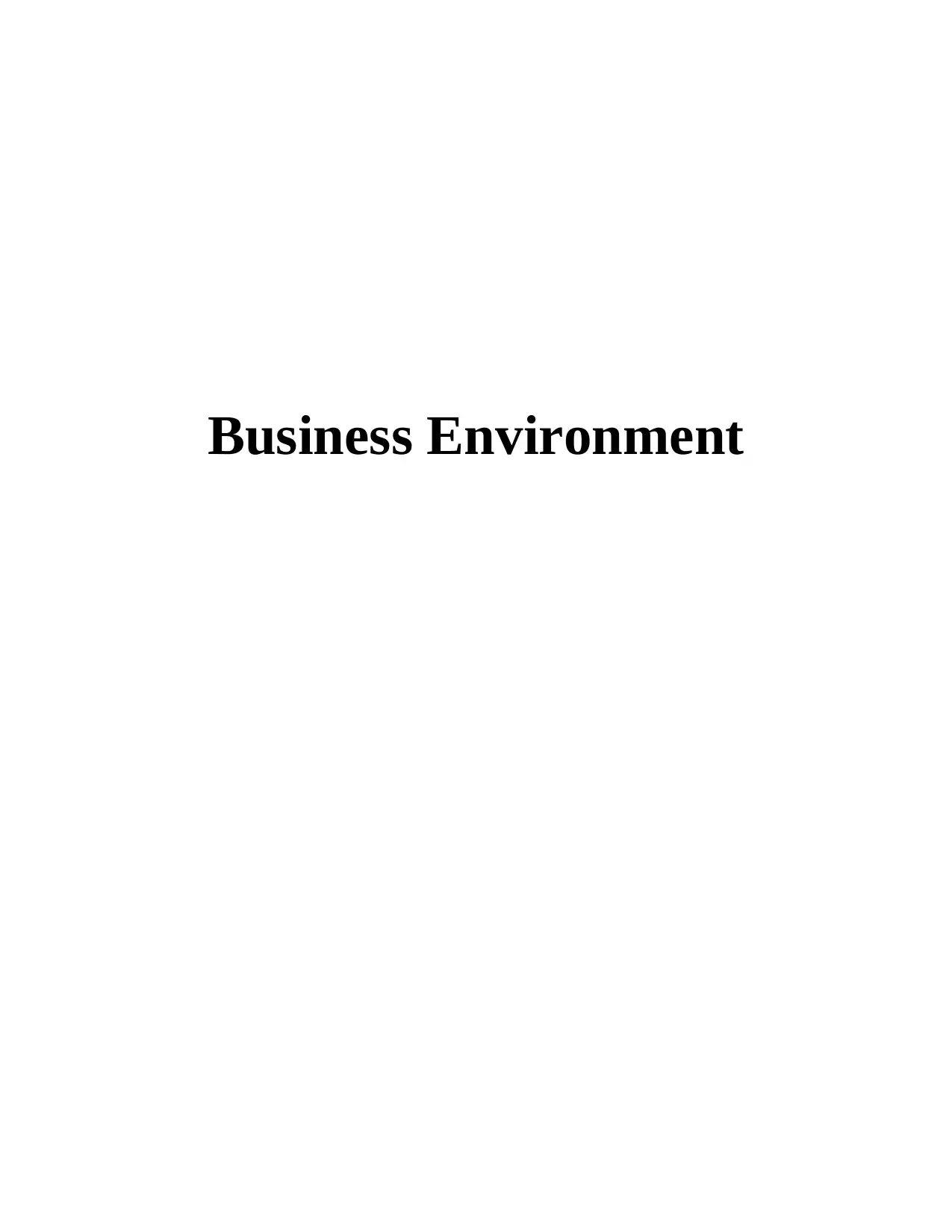
Business Environment
Paraphrase This Document
Need a fresh take? Get an instant paraphrase of this document with our AI Paraphraser
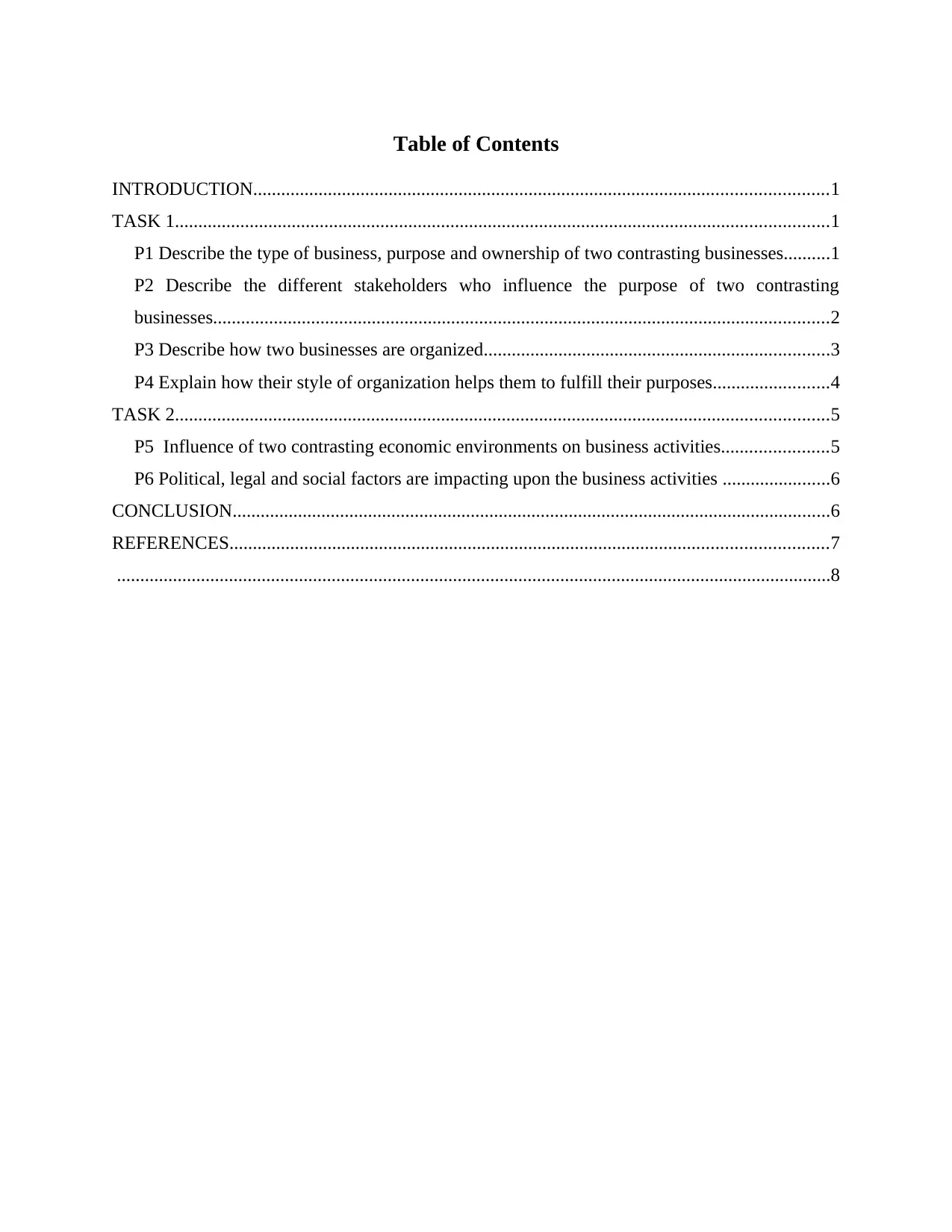
Table of Contents
INTRODUCTION...........................................................................................................................1
TASK 1............................................................................................................................................1
P1 Describe the type of business, purpose and ownership of two contrasting businesses..........1
P2 Describe the different stakeholders who influence the purpose of two contrasting
businesses....................................................................................................................................2
P3 Describe how two businesses are organized..........................................................................3
P4 Explain how their style of organization helps them to fulfill their purposes.........................4
TASK 2............................................................................................................................................5
P5 Influence of two contrasting economic environments on business activities.......................5
P6 Political, legal and social factors are impacting upon the business activities .......................6
CONCLUSION................................................................................................................................6
REFERENCES................................................................................................................................7
.........................................................................................................................................................8
INTRODUCTION...........................................................................................................................1
TASK 1............................................................................................................................................1
P1 Describe the type of business, purpose and ownership of two contrasting businesses..........1
P2 Describe the different stakeholders who influence the purpose of two contrasting
businesses....................................................................................................................................2
P3 Describe how two businesses are organized..........................................................................3
P4 Explain how their style of organization helps them to fulfill their purposes.........................4
TASK 2............................................................................................................................................5
P5 Influence of two contrasting economic environments on business activities.......................5
P6 Political, legal and social factors are impacting upon the business activities .......................6
CONCLUSION................................................................................................................................6
REFERENCES................................................................................................................................7
.........................................................................................................................................................8

⊘ This is a preview!⊘
Do you want full access?
Subscribe today to unlock all pages.

Trusted by 1+ million students worldwide
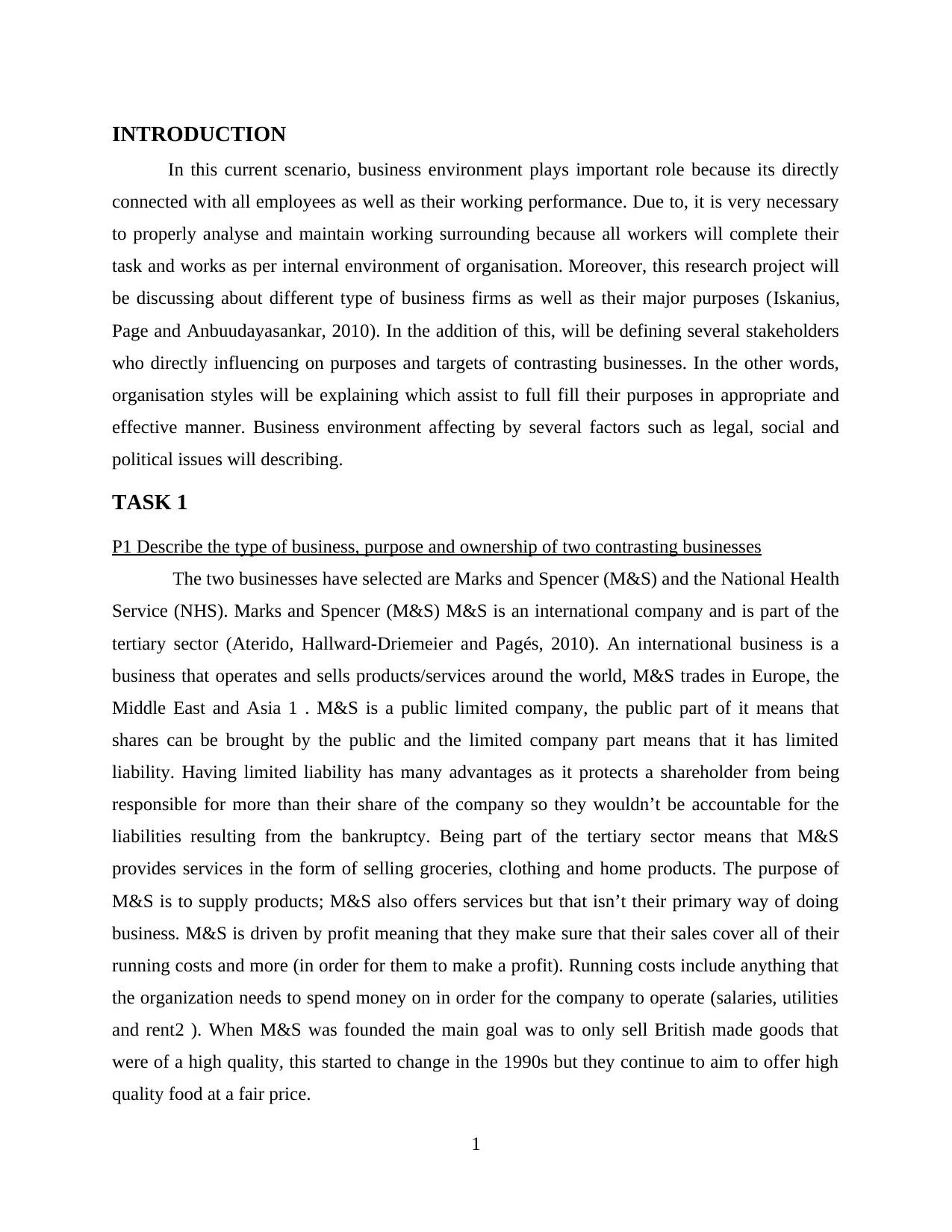
INTRODUCTION
In this current scenario, business environment plays important role because its directly
connected with all employees as well as their working performance. Due to, it is very necessary
to properly analyse and maintain working surrounding because all workers will complete their
task and works as per internal environment of organisation. Moreover, this research project will
be discussing about different type of business firms as well as their major purposes (Iskanius,
Page and Anbuudayasankar, 2010). In the addition of this, will be defining several stakeholders
who directly influencing on purposes and targets of contrasting businesses. In the other words,
organisation styles will be explaining which assist to full fill their purposes in appropriate and
effective manner. Business environment affecting by several factors such as legal, social and
political issues will describing.
TASK 1
P1 Describe the type of business, purpose and ownership of two contrasting businesses
The two businesses have selected are Marks and Spencer (M&S) and the National Health
Service (NHS). Marks and Spencer (M&S) M&S is an international company and is part of the
tertiary sector (Aterido, Hallward-Driemeier and Pagés, 2010). An international business is a
business that operates and sells products/services around the world, M&S trades in Europe, the
Middle East and Asia 1 . M&S is a public limited company, the public part of it means that
shares can be brought by the public and the limited company part means that it has limited
liability. Having limited liability has many advantages as it protects a shareholder from being
responsible for more than their share of the company so they wouldn’t be accountable for the
liabilities resulting from the bankruptcy. Being part of the tertiary sector means that M&S
provides services in the form of selling groceries, clothing and home products. The purpose of
M&S is to supply products; M&S also offers services but that isn’t their primary way of doing
business. M&S is driven by profit meaning that they make sure that their sales cover all of their
running costs and more (in order for them to make a profit). Running costs include anything that
the organization needs to spend money on in order for the company to operate (salaries, utilities
and rent2 ). When M&S was founded the main goal was to only sell British made goods that
were of a high quality, this started to change in the 1990s but they continue to aim to offer high
quality food at a fair price.
1
In this current scenario, business environment plays important role because its directly
connected with all employees as well as their working performance. Due to, it is very necessary
to properly analyse and maintain working surrounding because all workers will complete their
task and works as per internal environment of organisation. Moreover, this research project will
be discussing about different type of business firms as well as their major purposes (Iskanius,
Page and Anbuudayasankar, 2010). In the addition of this, will be defining several stakeholders
who directly influencing on purposes and targets of contrasting businesses. In the other words,
organisation styles will be explaining which assist to full fill their purposes in appropriate and
effective manner. Business environment affecting by several factors such as legal, social and
political issues will describing.
TASK 1
P1 Describe the type of business, purpose and ownership of two contrasting businesses
The two businesses have selected are Marks and Spencer (M&S) and the National Health
Service (NHS). Marks and Spencer (M&S) M&S is an international company and is part of the
tertiary sector (Aterido, Hallward-Driemeier and Pagés, 2010). An international business is a
business that operates and sells products/services around the world, M&S trades in Europe, the
Middle East and Asia 1 . M&S is a public limited company, the public part of it means that
shares can be brought by the public and the limited company part means that it has limited
liability. Having limited liability has many advantages as it protects a shareholder from being
responsible for more than their share of the company so they wouldn’t be accountable for the
liabilities resulting from the bankruptcy. Being part of the tertiary sector means that M&S
provides services in the form of selling groceries, clothing and home products. The purpose of
M&S is to supply products; M&S also offers services but that isn’t their primary way of doing
business. M&S is driven by profit meaning that they make sure that their sales cover all of their
running costs and more (in order for them to make a profit). Running costs include anything that
the organization needs to spend money on in order for the company to operate (salaries, utilities
and rent2 ). When M&S was founded the main goal was to only sell British made goods that
were of a high quality, this started to change in the 1990s but they continue to aim to offer high
quality food at a fair price.
1
Paraphrase This Document
Need a fresh take? Get an instant paraphrase of this document with our AI Paraphraser
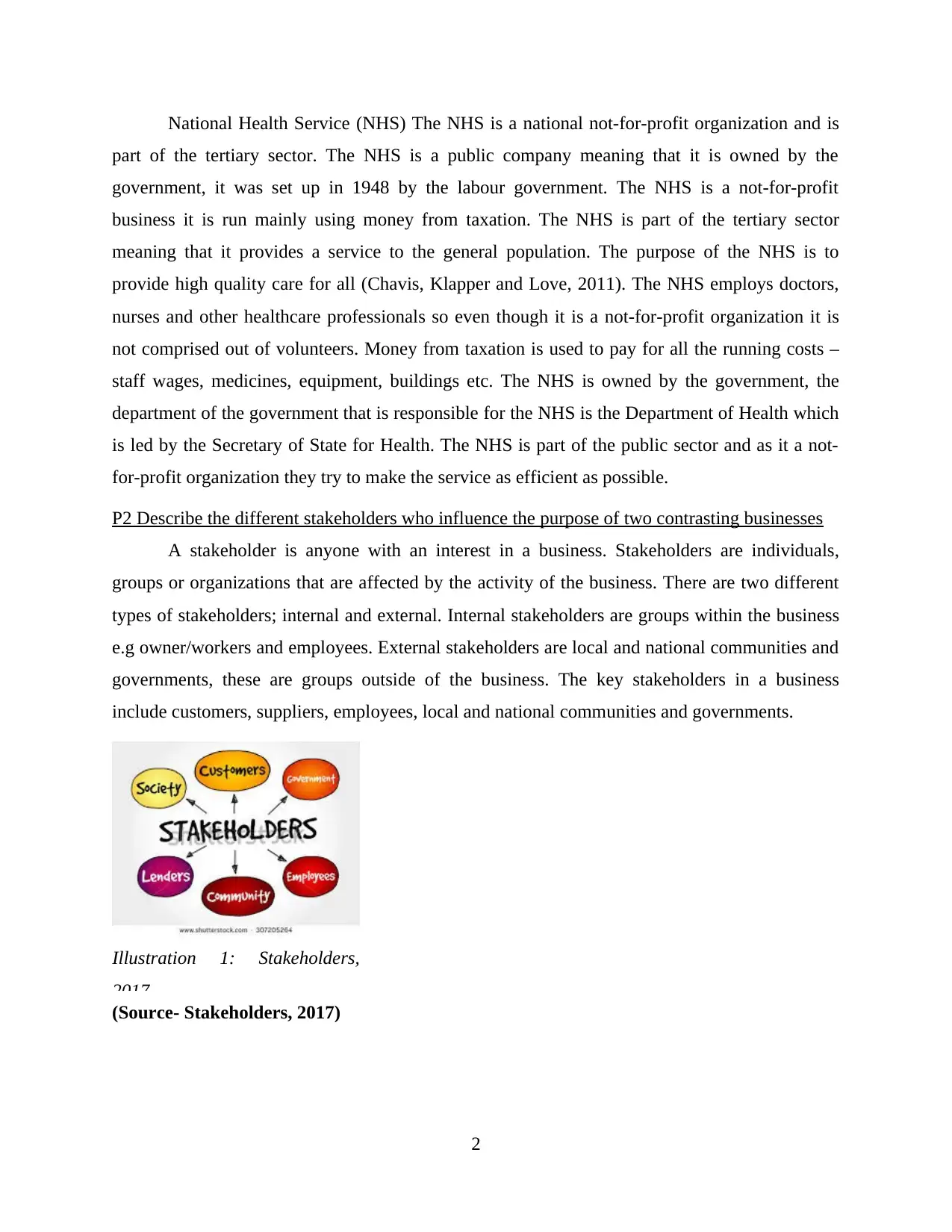
National Health Service (NHS) The NHS is a national not-for-profit organization and is
part of the tertiary sector. The NHS is a public company meaning that it is owned by the
government, it was set up in 1948 by the labour government. The NHS is a not-for-profit
business it is run mainly using money from taxation. The NHS is part of the tertiary sector
meaning that it provides a service to the general population. The purpose of the NHS is to
provide high quality care for all (Chavis, Klapper and Love, 2011). The NHS employs doctors,
nurses and other healthcare professionals so even though it is a not-for-profit organization it is
not comprised out of volunteers. Money from taxation is used to pay for all the running costs –
staff wages, medicines, equipment, buildings etc. The NHS is owned by the government, the
department of the government that is responsible for the NHS is the Department of Health which
is led by the Secretary of State for Health. The NHS is part of the public sector and as it a not-
for-profit organization they try to make the service as efficient as possible.
P2 Describe the different stakeholders who influence the purpose of two contrasting businesses
A stakeholder is anyone with an interest in a business. Stakeholders are individuals,
groups or organizations that are affected by the activity of the business. There are two different
types of stakeholders; internal and external. Internal stakeholders are groups within the business
e.g owner/workers and employees. External stakeholders are local and national communities and
governments, these are groups outside of the business. The key stakeholders in a business
include customers, suppliers, employees, local and national communities and governments.
Illustration 1: Stakeholders,
2017
(Source- Stakeholders, 2017)
2
part of the tertiary sector. The NHS is a public company meaning that it is owned by the
government, it was set up in 1948 by the labour government. The NHS is a not-for-profit
business it is run mainly using money from taxation. The NHS is part of the tertiary sector
meaning that it provides a service to the general population. The purpose of the NHS is to
provide high quality care for all (Chavis, Klapper and Love, 2011). The NHS employs doctors,
nurses and other healthcare professionals so even though it is a not-for-profit organization it is
not comprised out of volunteers. Money from taxation is used to pay for all the running costs –
staff wages, medicines, equipment, buildings etc. The NHS is owned by the government, the
department of the government that is responsible for the NHS is the Department of Health which
is led by the Secretary of State for Health. The NHS is part of the public sector and as it a not-
for-profit organization they try to make the service as efficient as possible.
P2 Describe the different stakeholders who influence the purpose of two contrasting businesses
A stakeholder is anyone with an interest in a business. Stakeholders are individuals,
groups or organizations that are affected by the activity of the business. There are two different
types of stakeholders; internal and external. Internal stakeholders are groups within the business
e.g owner/workers and employees. External stakeholders are local and national communities and
governments, these are groups outside of the business. The key stakeholders in a business
include customers, suppliers, employees, local and national communities and governments.
Illustration 1: Stakeholders,
2017
(Source- Stakeholders, 2017)
2

Suppliers- It want steady orders and prompt payment, they also want to feel valued by
the company that they supply. Suppliers are interested in supplying M&S with goods because of
the business they get from them and the profit that they receive. They influence M&S because if
the suppliers go out of business then M&S will have to find new suppliers that may not offer the
same high standards as the previous supplier (Welford, 2013).
Employees- Employees within a business influence a reasonable amount of what
direction the business goes. The employees are the workers, which allow the business to sell its
products or run, and without employees depending on the business, it is impossible to make any
sort of impact on the business world. This is why employees must have particular rights as well
as given various exclusive options An example of a consumer shop such as M&S, the employees
after a certain time are given discount within that shop, this is known as “employee discount”.
This sort of exclusive discount is given to the employees as a reward for essentially working at
the store, to encourage the employees who work there to stay.
Customers- A business that sells anything to customers consequently means that
customers (stakeholders) who a large influence on a company as their money is what keep the
company running. Customer feedback is vital for a company, as companies that ignore feedback
from its customers often have no competitive edge over its competitors. M&S ensure that they
act on feedback by implanting a feedback form on their website, which allows users to describe
their experience with M&S even with a particular store location nearby to their home. This
allows M&S to display that they care about and act on feedback from their customers (Moutinho,
2011).
P3 Describe how two businesses are organized
Organizational structures refers to the hierarchy of an organization and how the
components of this hierarchy work together to achieve the objectives of the company. For
example, in a particular area there are staffs who are reporting their managers who then report to
another manager or to the director CEO, depending on the difficulty of the structure or on the
size of the actual organization.
Functional: For all businesses, whether they are big or small, they each have a number
of functions in which they need to carry out to ensure that the business runs smoothly. These are
also links to other aims and objectives of the business and what it wants to achieve. The aim of
3
the company that they supply. Suppliers are interested in supplying M&S with goods because of
the business they get from them and the profit that they receive. They influence M&S because if
the suppliers go out of business then M&S will have to find new suppliers that may not offer the
same high standards as the previous supplier (Welford, 2013).
Employees- Employees within a business influence a reasonable amount of what
direction the business goes. The employees are the workers, which allow the business to sell its
products or run, and without employees depending on the business, it is impossible to make any
sort of impact on the business world. This is why employees must have particular rights as well
as given various exclusive options An example of a consumer shop such as M&S, the employees
after a certain time are given discount within that shop, this is known as “employee discount”.
This sort of exclusive discount is given to the employees as a reward for essentially working at
the store, to encourage the employees who work there to stay.
Customers- A business that sells anything to customers consequently means that
customers (stakeholders) who a large influence on a company as their money is what keep the
company running. Customer feedback is vital for a company, as companies that ignore feedback
from its customers often have no competitive edge over its competitors. M&S ensure that they
act on feedback by implanting a feedback form on their website, which allows users to describe
their experience with M&S even with a particular store location nearby to their home. This
allows M&S to display that they care about and act on feedback from their customers (Moutinho,
2011).
P3 Describe how two businesses are organized
Organizational structures refers to the hierarchy of an organization and how the
components of this hierarchy work together to achieve the objectives of the company. For
example, in a particular area there are staffs who are reporting their managers who then report to
another manager or to the director CEO, depending on the difficulty of the structure or on the
size of the actual organization.
Functional: For all businesses, whether they are big or small, they each have a number
of functions in which they need to carry out to ensure that the business runs smoothly. These are
also links to other aims and objectives of the business and what it wants to achieve. The aim of
3
⊘ This is a preview!⊘
Do you want full access?
Subscribe today to unlock all pages.

Trusted by 1+ million students worldwide
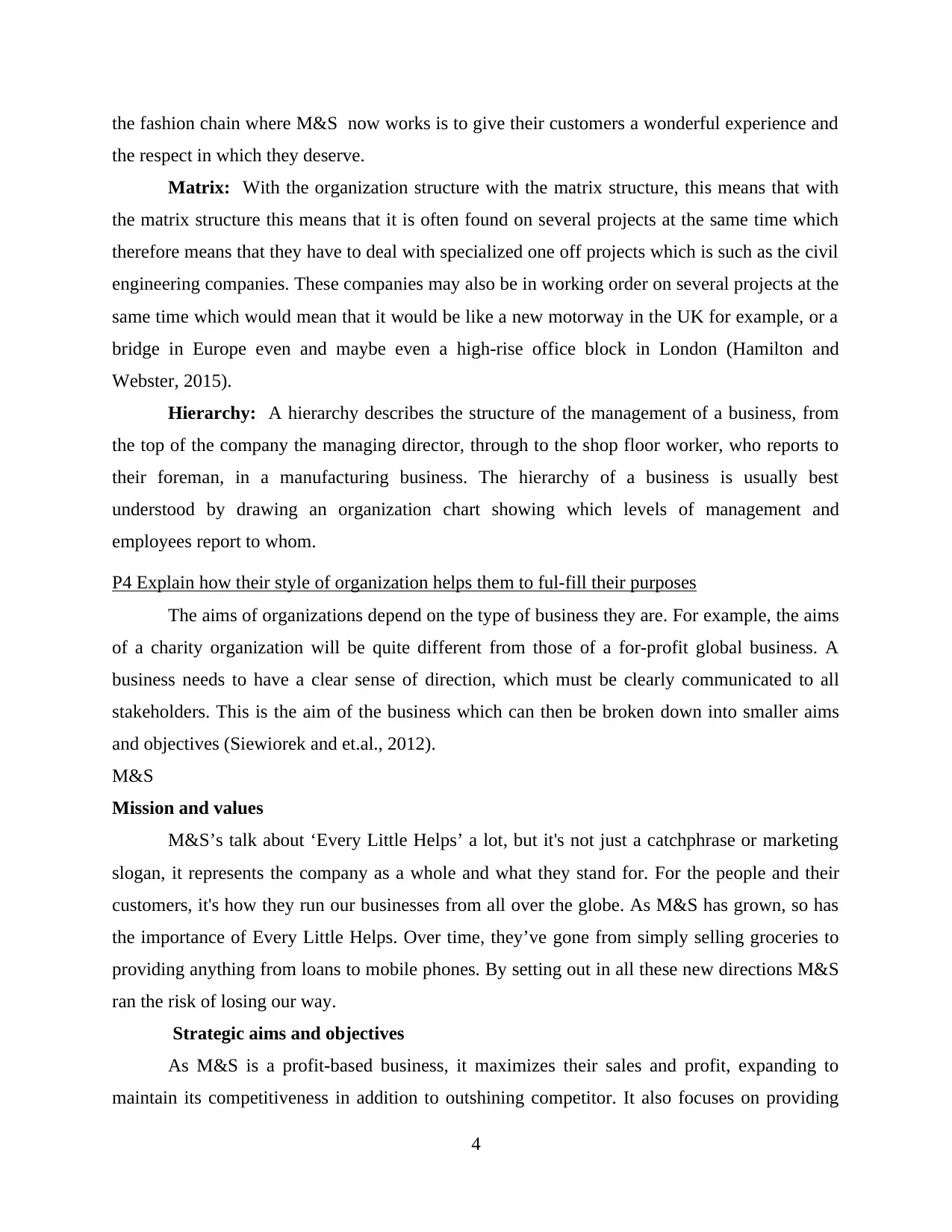
the fashion chain where M&S now works is to give their customers a wonderful experience and
the respect in which they deserve.
Matrix: With the organization structure with the matrix structure, this means that with
the matrix structure this means that it is often found on several projects at the same time which
therefore means that they have to deal with specialized one off projects which is such as the civil
engineering companies. These companies may also be in working order on several projects at the
same time which would mean that it would be like a new motorway in the UK for example, or a
bridge in Europe even and maybe even a high-rise office block in London (Hamilton and
Webster, 2015).
Hierarchy: A hierarchy describes the structure of the management of a business, from
the top of the company the managing director, through to the shop floor worker, who reports to
their foreman, in a manufacturing business. The hierarchy of a business is usually best
understood by drawing an organization chart showing which levels of management and
employees report to whom.
P4 Explain how their style of organization helps them to ful-fill their purposes
The aims of organizations depend on the type of business they are. For example, the aims
of a charity organization will be quite different from those of a for-profit global business. A
business needs to have a clear sense of direction, which must be clearly communicated to all
stakeholders. This is the aim of the business which can then be broken down into smaller aims
and objectives (Siewiorek and et.al., 2012).
M&S
Mission and values
M&S’s talk about ‘Every Little Helps’ a lot, but it's not just a catchphrase or marketing
slogan, it represents the company as a whole and what they stand for. For the people and their
customers, it's how they run our businesses from all over the globe. As M&S has grown, so has
the importance of Every Little Helps. Over time, they’ve gone from simply selling groceries to
providing anything from loans to mobile phones. By setting out in all these new directions M&S
ran the risk of losing our way.
Strategic aims and objectives
As M&S is a profit-based business, it maximizes their sales and profit, expanding to
maintain its competitiveness in addition to outshining competitor. It also focuses on providing
4
the respect in which they deserve.
Matrix: With the organization structure with the matrix structure, this means that with
the matrix structure this means that it is often found on several projects at the same time which
therefore means that they have to deal with specialized one off projects which is such as the civil
engineering companies. These companies may also be in working order on several projects at the
same time which would mean that it would be like a new motorway in the UK for example, or a
bridge in Europe even and maybe even a high-rise office block in London (Hamilton and
Webster, 2015).
Hierarchy: A hierarchy describes the structure of the management of a business, from
the top of the company the managing director, through to the shop floor worker, who reports to
their foreman, in a manufacturing business. The hierarchy of a business is usually best
understood by drawing an organization chart showing which levels of management and
employees report to whom.
P4 Explain how their style of organization helps them to ful-fill their purposes
The aims of organizations depend on the type of business they are. For example, the aims
of a charity organization will be quite different from those of a for-profit global business. A
business needs to have a clear sense of direction, which must be clearly communicated to all
stakeholders. This is the aim of the business which can then be broken down into smaller aims
and objectives (Siewiorek and et.al., 2012).
M&S
Mission and values
M&S’s talk about ‘Every Little Helps’ a lot, but it's not just a catchphrase or marketing
slogan, it represents the company as a whole and what they stand for. For the people and their
customers, it's how they run our businesses from all over the globe. As M&S has grown, so has
the importance of Every Little Helps. Over time, they’ve gone from simply selling groceries to
providing anything from loans to mobile phones. By setting out in all these new directions M&S
ran the risk of losing our way.
Strategic aims and objectives
As M&S is a profit-based business, it maximizes their sales and profit, expanding to
maintain its competitiveness in addition to outshining competitor. It also focuses on providing
4
Paraphrase This Document
Need a fresh take? Get an instant paraphrase of this document with our AI Paraphraser
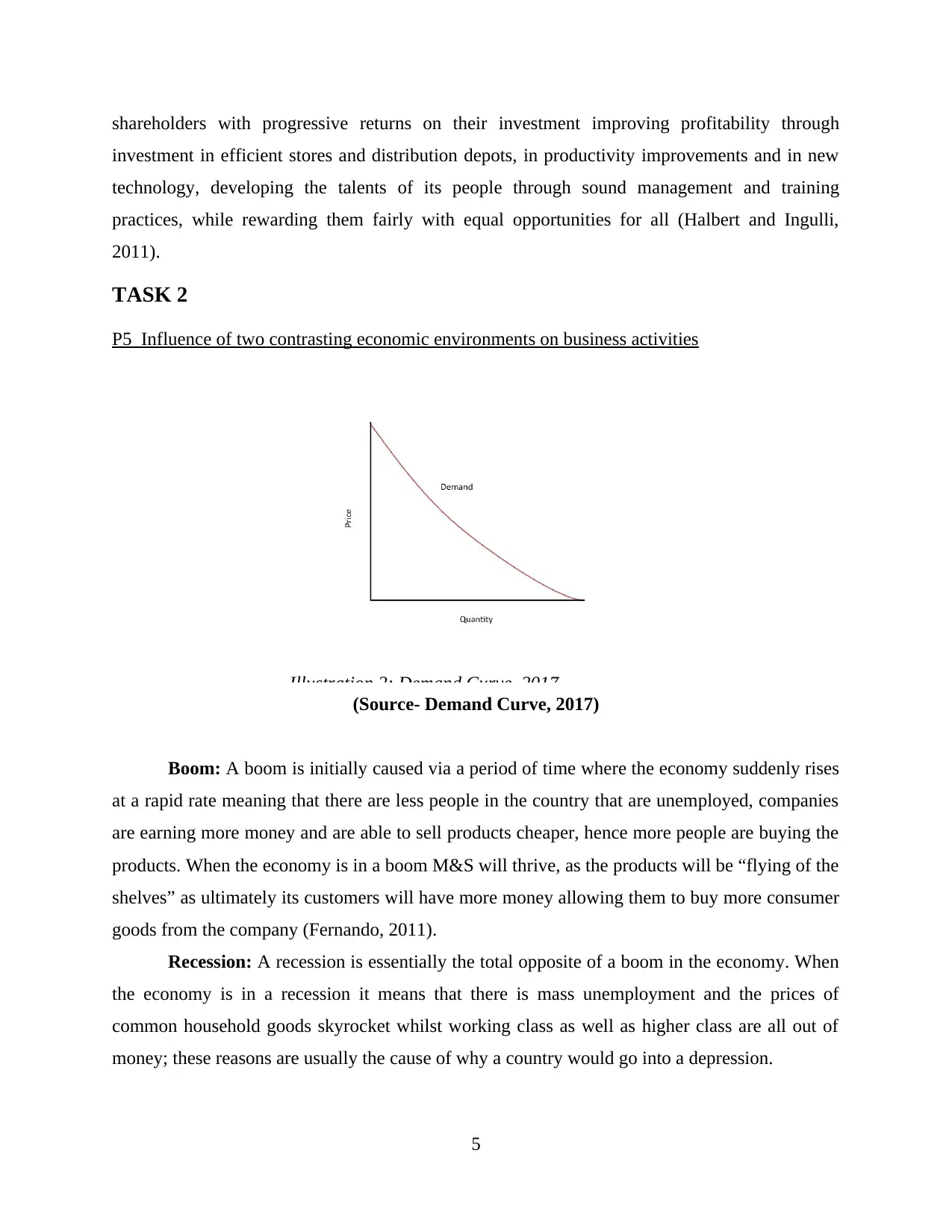
shareholders with progressive returns on their investment improving profitability through
investment in efficient stores and distribution depots, in productivity improvements and in new
technology, developing the talents of its people through sound management and training
practices, while rewarding them fairly with equal opportunities for all (Halbert and Ingulli,
2011).
TASK 2
P5 Influence of two contrasting economic environments on business activities
(Source- Demand Curve, 2017)
Boom: A boom is initially caused via a period of time where the economy suddenly rises
at a rapid rate meaning that there are less people in the country that are unemployed, companies
are earning more money and are able to sell products cheaper, hence more people are buying the
products. When the economy is in a boom M&S will thrive, as the products will be “flying of the
shelves” as ultimately its customers will have more money allowing them to buy more consumer
goods from the company (Fernando, 2011).
Recession: A recession is essentially the total opposite of a boom in the economy. When
the economy is in a recession it means that there is mass unemployment and the prices of
common household goods skyrocket whilst working class as well as higher class are all out of
money; these reasons are usually the cause of why a country would go into a depression.
5
Illustration 2: Demand Curve, 2017
investment in efficient stores and distribution depots, in productivity improvements and in new
technology, developing the talents of its people through sound management and training
practices, while rewarding them fairly with equal opportunities for all (Halbert and Ingulli,
2011).
TASK 2
P5 Influence of two contrasting economic environments on business activities
(Source- Demand Curve, 2017)
Boom: A boom is initially caused via a period of time where the economy suddenly rises
at a rapid rate meaning that there are less people in the country that are unemployed, companies
are earning more money and are able to sell products cheaper, hence more people are buying the
products. When the economy is in a boom M&S will thrive, as the products will be “flying of the
shelves” as ultimately its customers will have more money allowing them to buy more consumer
goods from the company (Fernando, 2011).
Recession: A recession is essentially the total opposite of a boom in the economy. When
the economy is in a recession it means that there is mass unemployment and the prices of
common household goods skyrocket whilst working class as well as higher class are all out of
money; these reasons are usually the cause of why a country would go into a depression.
5
Illustration 2: Demand Curve, 2017
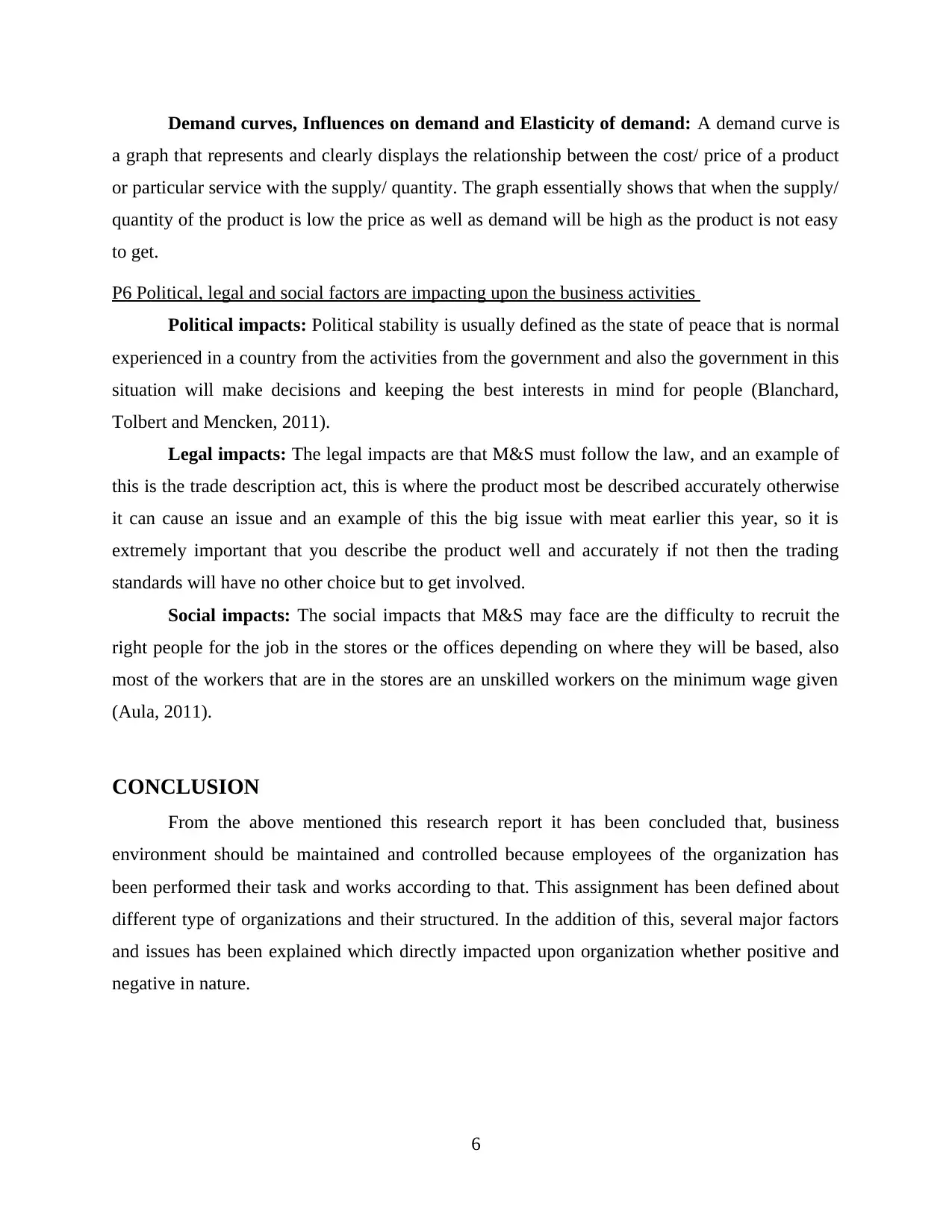
Demand curves, Influences on demand and Elasticity of demand: A demand curve is
a graph that represents and clearly displays the relationship between the cost/ price of a product
or particular service with the supply/ quantity. The graph essentially shows that when the supply/
quantity of the product is low the price as well as demand will be high as the product is not easy
to get.
P6 Political, legal and social factors are impacting upon the business activities
Political impacts: Political stability is usually defined as the state of peace that is normal
experienced in a country from the activities from the government and also the government in this
situation will make decisions and keeping the best interests in mind for people (Blanchard,
Tolbert and Mencken, 2011).
Legal impacts: The legal impacts are that M&S must follow the law, and an example of
this is the trade description act, this is where the product most be described accurately otherwise
it can cause an issue and an example of this the big issue with meat earlier this year, so it is
extremely important that you describe the product well and accurately if not then the trading
standards will have no other choice but to get involved.
Social impacts: The social impacts that M&S may face are the difficulty to recruit the
right people for the job in the stores or the offices depending on where they will be based, also
most of the workers that are in the stores are an unskilled workers on the minimum wage given
(Aula, 2011).
CONCLUSION
From the above mentioned this research report it has been concluded that, business
environment should be maintained and controlled because employees of the organization has
been performed their task and works according to that. This assignment has been defined about
different type of organizations and their structured. In the addition of this, several major factors
and issues has been explained which directly impacted upon organization whether positive and
negative in nature.
6
a graph that represents and clearly displays the relationship between the cost/ price of a product
or particular service with the supply/ quantity. The graph essentially shows that when the supply/
quantity of the product is low the price as well as demand will be high as the product is not easy
to get.
P6 Political, legal and social factors are impacting upon the business activities
Political impacts: Political stability is usually defined as the state of peace that is normal
experienced in a country from the activities from the government and also the government in this
situation will make decisions and keeping the best interests in mind for people (Blanchard,
Tolbert and Mencken, 2011).
Legal impacts: The legal impacts are that M&S must follow the law, and an example of
this is the trade description act, this is where the product most be described accurately otherwise
it can cause an issue and an example of this the big issue with meat earlier this year, so it is
extremely important that you describe the product well and accurately if not then the trading
standards will have no other choice but to get involved.
Social impacts: The social impacts that M&S may face are the difficulty to recruit the
right people for the job in the stores or the offices depending on where they will be based, also
most of the workers that are in the stores are an unskilled workers on the minimum wage given
(Aula, 2011).
CONCLUSION
From the above mentioned this research report it has been concluded that, business
environment should be maintained and controlled because employees of the organization has
been performed their task and works according to that. This assignment has been defined about
different type of organizations and their structured. In the addition of this, several major factors
and issues has been explained which directly impacted upon organization whether positive and
negative in nature.
6
⊘ This is a preview!⊘
Do you want full access?
Subscribe today to unlock all pages.

Trusted by 1+ million students worldwide

REFERENCES
Books and Journals
Aterido, R., Hallward-Driemeier, M. and Pagés, C., 2011. Big constraints to small firms’
growth? Business environment and employment growth across firms. Economic
Development and Cultural Change. 59(3). pp.609-647.
Aula, P., 2010. Social media, reputation risk and ambient publicity management. Strategy &
Leadership. 38(6). pp.43-49.
Blanchard, T. C., Tolbert, C. and Mencken, C., 2011. The health and wealth of US counties: how
the small business environment impacts alternative measures of development.
Cambridge Journal of Regions, Economy and Society. 5(1). pp.149-162.
Chavis, L. W., Klapper, L. F. and Love, I., 2011. The impact of the business environment on
young firm financing. The world bank economic review. 25(3). pp.486-507.
Fernando, A. C., 2011. Business environment. Pearson Education India.
Halbert, T. and Ingulli, E., 2011. Law and ethics in the business environment. Cengage
Learning.
Hamilton, L. and Webster, P., 2015. The international business environment. Oxford University
Press, USA.
Iskanius, P., Page, T. and Anbuudayasankar, S. P., 2010. The traditional industry sector in the
changing business environment–a case study of the Finnish steel product industry.
International Journal of Electronic Customer Relationship Management. 4(4). pp.395-
414.
Moutinho, L. ed., 2011. Strategic management in tourism. Cabi.
Siewiorek, A., and et.al., 2012. Learning leadership skills in a simulated business environment.
Computers & Education. 58(1). pp.121-135.
Welford, R., 2013. Hijacking environmentalism: Corporate responses to sustainable
development. Routledge.
Online
CEOs appear increasingly co`ncerned with the business environment, 2015. [Online]. Available
through: <http://blogs.lse.ac.uk/businessreview/2016/02/22/ceos-appear-increasingly-
concerned-with-the-business-environment/>. [Accessed on 19th August 2017]
7
Books and Journals
Aterido, R., Hallward-Driemeier, M. and Pagés, C., 2011. Big constraints to small firms’
growth? Business environment and employment growth across firms. Economic
Development and Cultural Change. 59(3). pp.609-647.
Aula, P., 2010. Social media, reputation risk and ambient publicity management. Strategy &
Leadership. 38(6). pp.43-49.
Blanchard, T. C., Tolbert, C. and Mencken, C., 2011. The health and wealth of US counties: how
the small business environment impacts alternative measures of development.
Cambridge Journal of Regions, Economy and Society. 5(1). pp.149-162.
Chavis, L. W., Klapper, L. F. and Love, I., 2011. The impact of the business environment on
young firm financing. The world bank economic review. 25(3). pp.486-507.
Fernando, A. C., 2011. Business environment. Pearson Education India.
Halbert, T. and Ingulli, E., 2011. Law and ethics in the business environment. Cengage
Learning.
Hamilton, L. and Webster, P., 2015. The international business environment. Oxford University
Press, USA.
Iskanius, P., Page, T. and Anbuudayasankar, S. P., 2010. The traditional industry sector in the
changing business environment–a case study of the Finnish steel product industry.
International Journal of Electronic Customer Relationship Management. 4(4). pp.395-
414.
Moutinho, L. ed., 2011. Strategic management in tourism. Cabi.
Siewiorek, A., and et.al., 2012. Learning leadership skills in a simulated business environment.
Computers & Education. 58(1). pp.121-135.
Welford, R., 2013. Hijacking environmentalism: Corporate responses to sustainable
development. Routledge.
Online
CEOs appear increasingly co`ncerned with the business environment, 2015. [Online]. Available
through: <http://blogs.lse.ac.uk/businessreview/2016/02/22/ceos-appear-increasingly-
concerned-with-the-business-environment/>. [Accessed on 19th August 2017]
7
Paraphrase This Document
Need a fresh take? Get an instant paraphrase of this document with our AI Paraphraser

8
1 out of 11
Related Documents
Your All-in-One AI-Powered Toolkit for Academic Success.
+13062052269
info@desklib.com
Available 24*7 on WhatsApp / Email
![[object Object]](/_next/static/media/star-bottom.7253800d.svg)
Unlock your academic potential
Copyright © 2020–2025 A2Z Services. All Rights Reserved. Developed and managed by ZUCOL.





